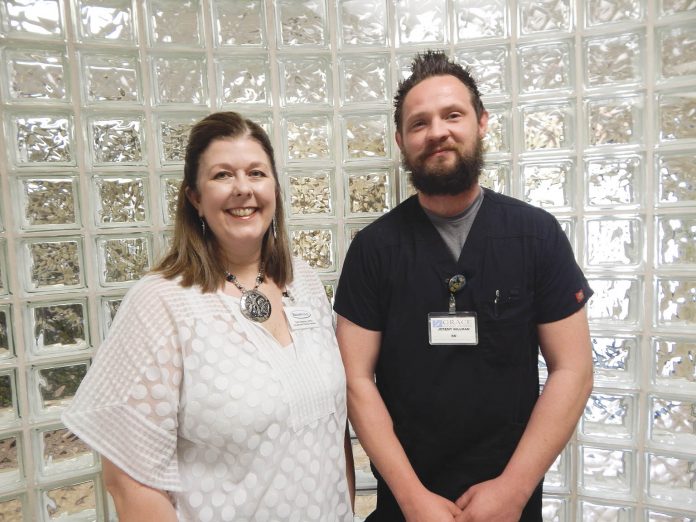
Nursing staff and therapists compliment patient centered care
by James Coburn, Staff Writer
As the lead therapist, Terri Downey, says she is very grateful for the nurses she works with in the Bridges Program at Grace Living Center Bethany.
“We appreciate our nurses so much, the whole nursing staff including the aides,” Downey said. “We are fortunate in the therapy department to get to spend a lot of time with our patients,” Downey said.
Communication with the nursing staff is paramount when spending time with patients, sometimes for three hours a day in the gym. If they’re showing signs of decline or if they are doing great, communication between the nurses and therapists is vital.
The Bridges Program is the skilled nursing program at Grace. And Grace Living Center Bethany is one of three Grace Living Centers in the metro offering the program. What sets the Bridges Program apart from some other Grace Living Centers is a separate dining area is provided for patients coming in. There is a separate entrance for the families to enter through the long-term care center.
“It’s really a separate whole unit for the patients we have here,” she said. “There’s different social activities. They have a court yard and more amenities than a regular skilled unit in a nursing home.”
Jeremy Killman, RN, has been working in the Bridges Program for just over a year.
One of the good things about being a nurse is the wide variety of fields available, said Killman, who earned his Bachelor of Science degree at the University of Central Oklahoma in Edmond.
“To be able to pick this type of environment was a little bit different because it’s dealing with a mixed population of people,” he said.
A variety of patient needs are met from strokes to post-operative care. Some of the patients are in their 40s and others are in their 90s.
“I sort of went into a specialty area right out of school which was cardiac. And it was fast paced, but getting the experience of getting to work with a broader range of people will just make me a better nurse down the line,” Killman explained. “I’ll be able to have a broader population of people to work with.”
The nurses at Grace need to have a lot of individual knowledge but the nursing staff takes a team oriented approach to patient care. The staff might have anywhere from nine to 20 patients at a time in the Bridges Program.
“I can’t ever take the attitude that I’m doing this all by myself,” he noted. “I rely on the nurse aides. I rely on the nurse that’s working with me. We bounce ideas off each other.”
The nurses prepare the patients for breakfast fairly early, he said. So being able to talk with the therapists about the wellness of a patient is an important observation to share, he said.
“As a nurse, what can I do that therapy is already working with so that we’re on the same page?” Killman will ask the therapists. The two fields have different yet complimentary training.
“To me it’s being able to have added knowledge. What can I do to see what would help me in my practice?” Killman said.
His approach is not to tell a patient to get up and out of bed when a therapist is telling someone to take it slow.
For Killman, the residents are the best part of the Bridges Program. Many of the patients come from a hospital to become stronger. He admires their resiliency.
“For a lot of older patients that you would think, ‘I don’t know how much they have left to go on.’ They amaze you with what they’ll try to do.”
Killman tries to make each patient feel at home to achieve that mental balance needed to get better.
“I enjoy the science aspect of it. I enjoy the people aspect of nursing,” Killman said. “But it came really from a place knowing there’s a whole lot of people out there needing really good care and somebody who is compassionate while they’re doing it.”











